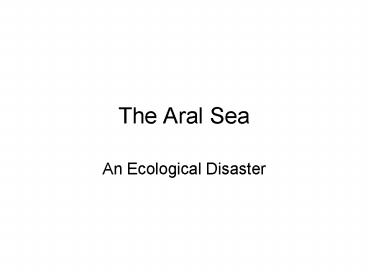The Aral Sea - PowerPoint PPT Presentation
1 / 27
Title:
The Aral Sea
Description:
Title: PowerPoint Presentation - The Aral Sea Author: Ridley College Last modified by: Ridley College Created Date: 1/26/2006 2:51:43 AM Document presentation format – PowerPoint PPT presentation
Number of Views:173
Avg rating:3.0/5.0
Title: The Aral Sea
1
The Aral Sea
- An Ecological Disaster
2
Where in the World?
3
1964
4
1964
1973
5
1964
1973
1987
6
1964
1973
1997
1987
7
1964
1973
1999
1987
1997
8
1964
1973
Over the past 30 - 40 years there has been a loss
of more than 60 of the lake's water. The lake
has shrunk from over 65,000 sq km to less than
half that size, exposing large areas of the lake
bed. From 1973 to 1987 the Aral dropped from
fourth to sixth among the world's largest lakes.
1999
1987
1997
9
1964
1973
The Aral, once the world's fourth-largest lake,
has lost 90 percent of its source waters and half
its surface area.
1999
1987
1997
10
(No Transcript)
11
2003
12
How did this happen?
For more than 30 years, water has been diverted
from the Amu-Darya and the Syr-Darya Rivers
feeding the Aral, to irrigate millions of acres
of land for cotton and rice production in Central
Asia.
13
How did this happen?
By 1960 water diverted from rivers that feed the
Aral Sea irrigated 11 million acres, most of it
former desert, producing enough cotton to make
the Soviet Union a net exporter. Today, these
rivers irrigate 20 million acres, extending as
far as China to the east and Afghanistan to the
south.
14
(No Transcript)
15
What are the Hydrological Consequences?
The lake's salt concentration increased from 10
to more than 23, obliterating twenty-four
species of fishes that once thrived there. Ships
lie abandoned on salt-encrusted seabeds, and
fishing villages are now far from water.
16
What are the Climatological Consequences?
The local climate has shifted. Desert land has
spread wetlands have dried up and sandstorms,
stirring up pesticide-laden dust, are more
common. Summers are hotter and dryer, winters
colder, growing seasons shorter.
17
What are the Health Consequences?
As the water retreated, salty soil remained on
the exposed lake bed. Dust storms have blown up
to 75,000 tons of this exposed soil annually,
dispersing its salt particles and pesticide
residues. This air pollution has caused
widespread nutritional and respiratory ailments .
Cancers have increased by 30 times arthritis by
60 times chronic bronchitis by 30 times.
18
What are the Economic Consequences?
Ships lie abandoned on salt-encrusted seabeds,
and fishing villages are now up to 50km. from
water. Besides, twenty-four species of fish that
once thrived there are now extirpated. Crop
yields have been diminished by the added
salinity, even in some of the same fields
irrigated with the diverted water.
19
(No Transcript)
20
(No Transcript)
21
(No Transcript)
22
(No Transcript)
23
(No Transcript)
24
What comes next?
Most recently Kazakhstan built a dam separating
the northern and southern portions. This should
restore the northern water levels (fed by the
Syr Darya), and condemn the southern portion
(water from the Amu Darya no longer reaches the
Aral Sea).
Despite international agencies' new clinics,
studies, and infrastructure solutions, and the
Central Asian republics' commitment to stabilized
water use, the Aral continues shrinking unless
irrigation is cut by one fifth-an unlikely
scenario, given the region's poverty and
dependence on farming, it will continue to
shrink.
25
(No Transcript)
26
(No Transcript)
27
Bibliography
- http//edcwww.cr.usgs.gov/earthshots/slow/Aral/Ara
l - A SEA CHANGE , Harper's Magazine, 0017789X,
Oct2000, Vol. 301, Issue 1805 - Google Earth.
- unimaps.com/aral-sea/































